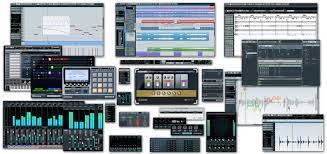Steinberg Cubase Introduced

Cubase is an advanced sound workstation (DAW) created by Steinberg for music and MIDI recording, organizing, and editing. The main variant, which was initially just a MIDI sequencer and ran on the Atari ST PC, was delivered in 1989. Cut-down renditions of Cubase are incorporated with practically all Yamaha sound and MIDI equipment, as well as equipment from different makers. These variants can be moved up to a further developed form at a rebate.
History In Steinberg Cubase:
Cubase has existed in three fundamental manifestations. At first, Cubase, which included just MIDI, was accessible on the Atari ST, Mac, and Windows.
After a short period of sound reconciliation: The following rendition, Cubase VST, included completely incorporated sound recording and blending alongside impacts. It added Virtual Studio Innovation (VST) support, a norm for sound modules, which prompted plenty of outsider impacts, both freeware and business. Cubase VST was exclusively for Mac and Windows; Atari support had been successfully dropped at this point, regardless of such equipment actually being a pillar in numerous studios. Cubase VST was offering a huge measure of capacity to the home client, however, PC equipment got some margin to make up for lost time. When it did, VST’s sound ability to alter was viewed as lacking, when contrasted and contenders like Star Apparatuses DAE and Computerized Entertainer MAS.
To address this, another variant of the program: Cubase SX (in light of Steinberg’s leader after the creation of programming Nuendo) was presented, which decisively adjusted the manner in which the program ran. This rendition required a lot of relearning for clients of more seasoned Cubase variants. In any case, when the new strategies for working were taken in, the enhancements in the treatment of sound and mechanization made for a more expert sequencer and sound proofreader.
An outstanding improvement with The presentation of Cubase SX was the high-level sound altering, particularly the capacity to ‘fix’ sound alters. Early renditions of Cubase VST didn’t have this capacity. Cubase SX additionally included continuous time-extending and change of sound beat, similar to Sonic Foundry’s pivotal Corrosive.
In January 2003: Steinberg was obtained by Apex Frameworks, inside which it worked as an autonomous organization prior to being offered to Yamaha Enterprise in December 2004.
In September 2006: Steinberg reported Cubase 4 – the replacement to Cubase SX3. Striking new elements incorporate a ‘control room’, a component intended to assist with making screen blends, and another arrangement of VST3 modules and instruments.
There are additionally lighter monetary choices by Steinberg: Initially named Cubasis, later becoming Cubase SE, and afterward Cubase Fundamental at rendition 4. For its 6th era, the program was renamed Cubase Components 6. The name change was done probably, on the grounds that its opponent Cakewalk had taken the Fundamental marking for its own entrance-level DAW programming, Sonar X1 Fundamental. While the full form of Cubase highlights limitless sound and MIDI tracks, lesser variants have limits. For example, Cubase Components 6 has a limit of 48 soundtracks and 64 MIDI tracks, and Cubase Craftsman 6 proposition 64 sounds and 128 MIDI tracks.
In 2013: Steinberg presented Cubasis for iPad, a Cubase for iOS. This variant was a full rework and upholds MIDI and soundtracks, audio bus, and virtual MIDI to work with outer music applications from the first versions.[9] In 2016, Cubasis 2 was delivered as a free update with new highlights, for example, ongoing time-extending, pitch-moving for changing the key, a “channel strip” impacts suite, and new modules and sounds. In 2017, Steinberg got the MIPA for Cubasis 2 in the Versatile Music Application class at the Musikmesse in Frankfurt. In late 2019, Cubasis 3 followed as a new application and included a bunch of tracks, an “Expert Strip” impacts suite, a patched-up MediaBay, more impacts, and a lot more elements notwithstanding iPhone support. In mid-2020, Cubasis 3 was delivered for Android tablets and smartphones.

Features & Highlights
Channel Scratchpad:
- Every one of his channels has its own scratchpad for adding notes and remarks to each channel.
Mass Channel Commodity:
- This component permits you to blend various channels without a moment’s delay.
Appreciate Variety Blending Channels:
- This will assist you with effectively finding the tunes you want and focusing all alone.
Alter Your Substance:
- This makes it simple to find and arrange happy with MediaBay.
Deal with the Business Interaction:
- You can undoubtedly alter custom exchanges and windows for habitually utilized work processes.
Consolidated Choice Apparatuses:
- This element permits you to consolidate various apparatuses for concurrent use.
Cutting edge Sound Motor:
- This sound system assists with making immaculate sound quality without any problem.
Document Following:
- This permits you to trade sound documents, cash apparatuses, MIDI, and video tracks as track records.
Actually, take a look at the Defers in Your Ventures:
- This oversees postpones in recording or answering craftsmen.
Sound Help for Irregular Access (ARA):
- This helps make it simple to utilize when altering soundtracks.
What’s New in Cubase?
- It offers a MultiTap delay with limitless imaginative conceivable outcomes.
- Presently you can likewise make macros quicker than previously.
- The rating proofreader incorporates all the more remarkable and instinctive highlights.
- You can now play MP4 (H.264) video with a 16-bit sound system sound.
- Additionally, you can promptly track down the right channels.
- This variant incorporates what could be compared to ghostly correlation for a more exact refinement of your
- blend.
- Presently you can join a few undertakings and items with one integral asset.
- Padshop incorporates more imaginative apparatuses and significant thoughts.
- The new protected start mode permits you to run the program without outsider modules.
- The most recent rendition makes it simple to import melodies from projects.
- It offers further developed scale and development in enormous undertakings.
System Requirements:
- Something like 4 GB of (RAM)
- The program runs on basically a quad-center processor.
- Screen size 1280x768p.
- It likewise needs a 2 GB free hard drive.
- Dynamic web association with the initiate.
- Cubase Star upholds Windows and Macintosh working frameworks.
- The free download of Voicemod Star.
How to Install Steinberg Cubase?
- Debilitate the Windows firewall.
- Then, at that point, download Cubase Full from the connection underneath.
- Introduce, however, don’t utilize this test.
- Save in the introduced Cubase organizer.
- Download a preliminary form of Cubase from the authority site.
- Sit tight for the following system.
- Try to actuate.
- Utilize the full variant of Cubase free of charge.


